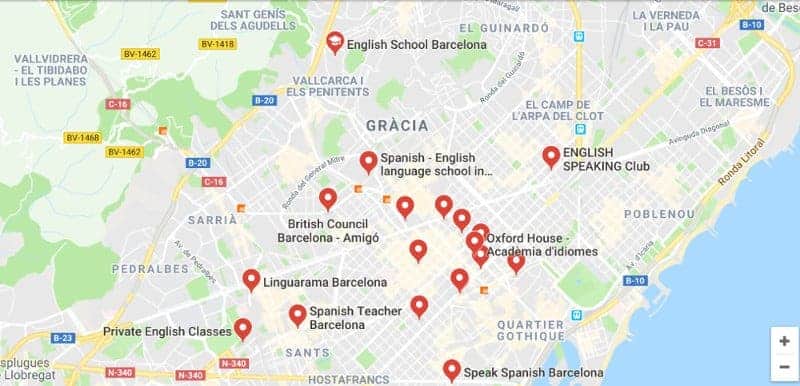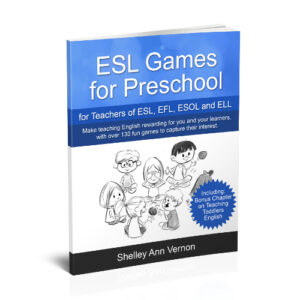If you have a language school or a private tutor, this post may help you get more students. It’s relevant for all ages and all types of new teaching businesses. I’ve started several teaching businesses and, wherever I was, I could always get more students! So many people want to learn English today; I’m sure you can be successful too, even if you have no money to start.
Choose your business name
I suggest A1 English + your town.
– Why A1? Because if you advertise in the local phone book or yellow pages, listings are in alphabetical order. A1 will be a the top.
– Why your town? People in Barcelona want a teacher in Barcelona. People in Shanghai want a teacher in Shanghai. To be found online, you need to be as precise as possible. I just searched for “English lessons” and found over 700 million results. Searching for “English in Barcelona” there were 27 million. And “English in Poblenou Barcelona, 100,000.
Make your business card or flyer
Start by making a business card: A1 English Barcelona. Native speaker. Fun lessons. All Ages and Levels. FREE trial lesson, just call ……… or visit www.A1-English-Barcelona.com
Give students a great reason to come to you
– Offer a free trial lesson and put that on your business card – that way, you get people in the door!
– Have a pleasant space for lessons. It’s fine if it’s at your home. Make sure it’s super clean, of course!
– Be local. If you are near your students, it’s easy for them to get to you.
– As soon as you can, offer small groups, that can be cheaper per pupil, but more money for you in total.
– Propose an English outing that is free for all your pupils, anyone welcome, where you go and see a movie in English, or go to a restaurant together – like an Irish pub, and everyone has to speak English all evening. Students buy their own tickets or meals.
Free local advertising
– Using your business cards, advertise in all the local shops where you can display a free ad. For example, there might be noticeboards at the local supermarket, shelves for business cards in shops, libraries, learning centers, waiting rooms, anywhere people are allowed to post an ad or leave a card, leave yours.
– Start with everything surrounding your house or the location you plan to use for lessons and work out from there. Leave cards in the halls of buildings around you. The more it’s local, the easier it is for people to come to you. Would you rather have a teacher next door or on the other side of town?
– If you have a car, get stickers on it with your business name and phone number. Leave this step till later if you are on a tight budget.
Target learning centers
– Go to the local schools and ask to meet the department head, offer your services for any pupils struggling, leave your contact details and business card.
– Hand out your business cards outside schools when parents collect their kids. Introduce yourself, say that you help with homework and in particular with English, and offer your card.
– Put notices in the university library and language department. Then, go back and re-post them every week – some people might take your messages down. In the beginning you need to be on it!
– Go into business buildings, leave your cards at reception or on a noticeboard, or post them in the letterboxes. Then, offer a free lesson to the boss or the human resources manager.
Do not shoot yourself in the foot
– Do not register with a company that offers tuition – you won’t be able to teach on the side during or even after your contract because they have non-competition clauses in their contracts. Those companies charge a fortune to customers, but you only get paid peanuts. It’s best to find your own clients and go direct. You can undercut all those online companies easily and still earn more.
– Don’t be too cheap. Giving lessons for peanuts undermines the value of your class. Instead, price yourself at market value or slightly more. However, if you want to help people who struggle financially, put them on a waiting list until you have a small group. Each participant can then pay peanuts, but you still end up with a decent salary.
– Even if you don’t have many customers, don’t take people who are on the opposite side of town, so it takes you half an hour to get to their house and half an hour to get back. Because that lesson will take you two hours, plus ten minutes to prepare, and you are only being paid for one.
– Do not buy dozens of teaching resources. Why am I saying that? After all, I sell teaching resources for a living! Teachers often throw money at resources and don’t use half of them. You only need a few GOOD resources to get started. For your trial lesson, don’t use a book. Use games and have your student participate the whole time – not sitting there reading out a paragraph in a book. They can do that at home without a teacher.
Your shop front
Your shop front is your business card and a website. You only need a simple, one-page website to get started. Students need to know who you are, where you are, how much you charge, and how to get their free trial lesson.
Use a popular, trusted social media site for your country. On this page, tell customers:
– how to contact you
– how to get their free trial lesson
– a location map showing where the lessons take place
– the full address of your teaching location, to help searches online be specific
– a nice picture of yourself, smiling, looking straight at the camera, where people can see your open, friendly face clearly
You don’t need a super-duper website to get started. A free one will do. It’s just a contact page to get people to contact you for their free lesson. This is your shop front; it’s who you are and what you offer. You’ll be able to put testimonials on there from existing students in time.
Yellow Pages and Google Maps
Get your teaching business listed in the yellow pages and on Google maps and your local equivalents. You may have to pay for this, but it’s worth it. If you have no money at all, skip this step and come back to it once you have the budget.
The secret to your success
If your lessons are effective and fun, you will keep your students long-term. In addition, they will recommend you to others. That’s the key to success. Eventually, you won’t have to run around putting flyers out. You’ll have your base of customers and a network of people who recommend you. Be sure to use my resources to save you time preparing for lessons and make sure your classes are fun!
Kind regards
Shelley Ann Vernon
-
Sale Product on sale
 Games and Activities for Teens and Adults
Games and Activities for Teens and Adults€19.97Original price was: €19.97.€15.33Current price is: €15.33.Rated 5.00 out of 5 based on 12 customer ratings -
Sale Product on sale
 Teach Your Child English
Teach Your Child English€19.97Original price was: €19.97.€15.33Current price is: €15.33. -
 ESL Online Games€19.97Rated 5.00 out of 5 based on 4 customer ratings
ESL Online Games€19.97Rated 5.00 out of 5 based on 4 customer ratings -
Sale Product on sale
 ESL Games book for primary & middle school children
ESL Games book for primary & middle school children€19.97Original price was: €19.97.€15.33Current price is: €15.33.Rated 5.00 out of 5 based on 1 customer rating -
Sale Product on sale
 Preschool games book
Preschool games book€19.97Original price was: €19.97.€11.97Current price is: €11.97.






8 thoughts on “How to get more students for private tutoring or language classes”
Hello Shirley.
Thank you for all the tipps you send me. I teach business English to adults at their workplace. My real challenege is to get them to talk. Although I give them samples of answers I am expecting from them, loads of ideas, etc,., they say “I just can’t think of anything to say, even in their own native language”. After they have had loads of practise as regards the various tenses, and after giving them a sample of a very short story, when I asked them to construct their own story, something that had happened to them, but using the appropriate tenses, they couldn’t manage it. Perhaps you would have some ideas?
Another issue which these adults raise with me is, although some of my classes are very advanced, I mean C1 standard, it is the “little words in between” which holds them back from speaking more fluently. Any tip on this issue?.
Thanking you in advance.
Nora
Dear Nora,
Hello there and thanks very much for your comment.
An easy fix for your students, who can’t think of anything to say, even in their native language, is to have them choose topics around their interests and passions. Let students choose their own topics.
I’m going to do a blog on this subject, with more discussion ideas for you and I’ll post you here when it’s published!
In the meantime, have you got my book for teens and adults? It’s got loads of ideas, and it will definitely help you with this recalcitrant lot, who are probably tired!
Kind regards
Shelley Ann Vernon
I have had some success with encouraging clients to speak using role play. Shopping, including asking for a particular colour, size, price, Then advancing to making a complaint, returning an article for a refund. Depending on their profession or job we role-play job interviews or sometimes I give them a scenario and they become a news reporter and question me about something in the news and vice-versa. Other topics can be how to make their favourite cake/soup/sandwich. I think some professional adults have a problem suddenly becoming a student again and allowing them to assume certain roles can make them feel as if they are in control
Dear Amanda,
Thanks for your comment. I agree, it’s helpful to give students roles to play, with a fixed viewpoint, that is imposed by the role. Students feel less exposed when arguing a point in a role, rather than having a personal argument with someone else in class.
Shelley
Very helpful Shelly…..thanks.
Thank you for the helpful tips and strategies. I don’t have a question. I just enjoyed reading.
Hi, Shelley!
Thank you for all the great tips of this blog, I find them very useful!
I´m a private teacher from Brazil and at the moment I only give one-to-one lessons. My aim is to be able to form pairs, trios or in the max of four students together, which I think it´ll make it easier to have them speaking. In the one-to-one classes, the student only has the chance of speaking to me, the teacher. So, in the lessons, I propose the situation, using prompts and they´re guided to speak. I reckon speaking to a peer can be more realistic thus making they feel more comfortable to speak.
Regards,
Flávia
Hello Flavia,
Thanks for your comment. Yes, it’s definitely nice teaching in small groups, however conversation lessons are easily done one on one as well. One advantage is that you can delve into topics that your student likes talking about. I have a great book of games for teaching online, which does one to one and groups. Although this games book is written for online teaching, all the activities work face to face. There are plenty of ways to get your student talking, even if you only have one of them.
On the link below you’ll find various posts on teaching one to one. You could skim through these and hopefully get some ideas:
https://teachingenglishgames.com/category/esl-tutoring/
I have plays and skits that are great for speaking, and they work for one to one and groups too. So, if you drop me an email (via my contact page) I will send you one – please ask for AUSTRALIA. I’ll send you a lesson plan and skit you could use with any teenager, one on one.
All the best
Shelley